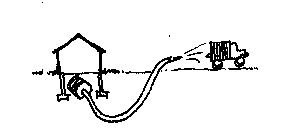| Water Conservation
Design Considerations:
Water Recovery- Water conservation should be promoted by water
recycling systems that limit demand and reduce sewage. Use water that is of lower
quality than drinking water, like reclaimed wastewater effluent, gray water, or runoff
from ground surfaces for toilet flushing or the irrigation of vegetation. In the
U.S. nearly all of our water supply is of drinking quality, yet toilet flushing
constitutes the largest use of indoor water.
Water Saving Fixtures- Water conservation should be promoted by
specifying low-use water fixtures and appliances. Installing water-saving fixtures
is easy, inexpensive, and provides immediate cost savings. The installation of new
low-flush toilets, faucet aerators, efficient showerheads, and efficient appliances can
cut water use by over 30%. Install fixtures that use 20% less water than the water
usage requirements in the Energy Policy Act of 1992.
Use fixtures that have been manufactured locally in an "sustaining" manner, to
avoid environmental impacts of transportation.
Water Efficient Landscaping- All exterior plantings should use
plants tolerant of climate, soils, and natural water availability, and they should not
need to receive watering from municipal potable water after the period of establishment is
complete.
Tools:
Case Studies to Research:
Water Saving Fixtures-
Boyne River Natural Science School, Shelburne, Ontario
Further Information:
Energy Policy Act of 1992. –Plumbing Fixture requirements (42 USC Section 6295 (j) )
EPA Publication # 812- B- 94- 002: “Lead in Drinking Water in Schools and
Non-residential Buildings” April 1994.
EPA Safe Drinking Water Hotline: (800) 426-4791
Web resources:
U.S. Department of Energy: EPIC- Pollution
Prevention Information Clearinghouse
National Engineering Laboratory: Enviro$en$e
National Extension
Water Quality Database |

